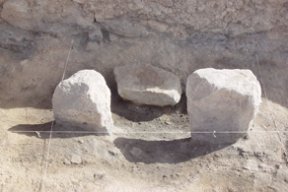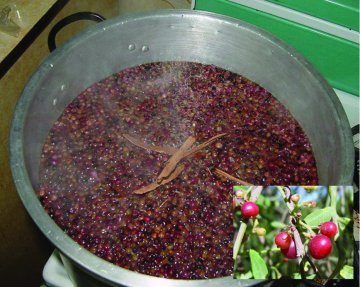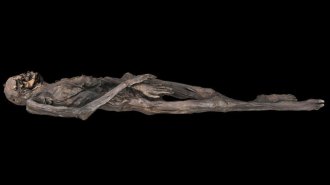Original Microbrews
From Egypt to Peru, archaeologists are unearthing breweries from long ago
Beer is nearly as old as civilization itself. It’s mentioned in Sumerian texts from more than 5,000 years ago. Starting in the 1950s, scientists have debated the notion that beer, not bread, was actually the impetus for the development of agriculture. Nearly every culture around the world has invented its own local concoction. Historically, brewing was a home-based operation, as part of the preparation of meals. From South America to the Middle East, beer production grew in scale with the rise of organized societies, scientists theorize, and later became primarily a function of the state. Beer was given to laborers or soldiers, incorporated into religious ceremonies, and drunk by politicians at state functions.


Almost all of what scientists know about beer’s history, however, is based on written evidence and drawings, including Egyptian hieroglyphs, Roman tablets, and European frescoes. Such works tell, for example, that thousands of years ago in Iraq, each city-state had its own brew master, says anthropologist James L. Phillips of the University of Illinois at Chicago.
While drinking vessels that probably held beer have been found here and there at archaeological sites around the globe, little physical evidence has been found for large-scale breweries.
“I’m sure they’re there,” says Phillips. “They’ve just never been excavated.”
Archaeologists in Peru are now optimistic that they’re on the track of an ancient, large-scale brewery. They’ve unearthed and identified tantalizing signs that rival those pieced together at other sites around the world. Because Peruvians have long consumed an unusual type of beer, the scientists expect to determine the site’s use conclusively by looking for chemical signatures of that beer that are not available for the usual malt brew.
Alcohol underground
Physical evidence of ancient beer brewing isn’t easy to come by. In most cultures, home beer making required only basic ingredients, a fire, a few cooking vessels, and some storage jars. None of these materials is unique to brewing. Jars found near a kiln could have been used to store barley or wheat for baking bread, and cooking pots could have been for heating any liquid.
To be unambiguous, a large-scale brewery site would contain storage vats and fermenting pots much larger than for home use and kilns that could heat large volumes of liquid.
Archaeologists so far haven’t unearthed a complete set of evidence. One of the oldest and best-attested potential breweries is at Hierakonpolis in southern Egypt and dates to 5,000 years ago, says Barry Kemp, an Egyptologist from the University of Cambridge in England.
At the site, Kemp’s team found large, well-heated conical vats that were encrusted on the inside with a cereal-based residue, says Kemp’s colleague Delwen Samuel, an archaeobotanist at University College London. The vats appeared to have been permanent structures, indicating a large-scale operation, and their shape suggests that they held liquid, which doesn’t jibe with baking, she says.
Another ancient brewery may be el-Amarna, along the Nile in middle Egypt. The city was the capital of ancient Egypt nearly 3,500 years ago, during the reign of King Tutankhamen’s father, Akhenaton. The archaeological site is located in what is thought to be the Sun Temple of Nefertiti, Akhenaton’s wife. Kemp and his colleagues found a complex of rooms that had been used for cereal processing. Ovens, charred grains, jars, and larger vessels indicate that the rooms were either a brewery or a bakery.
“No piece of equipment survives that can be unequivocally linked to brewing,” says Samuel, who studied the el-Amarna site with Kemp. “Bread and beer were staples of the ancient Egyptians, so it’s a matter of inference.”
However, writing and drawings from the site tip the scale toward breweries, she says.
In a different corner of the world, excavators at an English site called Vindolanda found a potential brewery dating from the times of the Roman Empire. Vindolanda was a Roman fort manned by German soldiers along Hadrian’s Wall in Northumberland, England. Robin Birley of the Vindolanda Trust, based in Hexham, and his team found preserved tablets dating from A.D. 100. Beer is specifically mentioned on a few of the tablets.
The scientists also found ceramic drinking vessels and two large flues, says Max Nelson of the University of Windsor in Ontario, who specializes in ancient beers. The flues, which would have been part of an oven or a kiln setup, make scientists suspect that the facility housed an operation larger than a home-based one, notes Nelson.
“This is the earliest evidence of nondomestic [beer] production in Europe,” he says.
Chemical evidence of beer would prove a site’s purpose once and for all, but it isn’t easy to come by. Alcohol is much too volatile to last over centuries, and any cereal-based residues in such vessels could have come from baking as easily as from brewing.
Archaeochemist Patrick McGovern of the University of Pennsylvania in Philadelphia has found traces of wine in vessels excavated in Egypt, Greece, and China. The high acidity and high alcohol content of wine preserves organic traces of grapes’ tannins. Such unequivocal chemical evidence for beer, however, just doesn’t exist.
High in the Andes
A promising potential brewery was discovered at a site in the Peruvian Andes about 7 years ago. Archaeologists have no decipherable ancient records of brewing or beer in South America, although they have found isolated jars. However, an unusual regional beer may provide the key to conclusively identifying an ancient brewery.
Archaeologist Patrick Ryan Williams and his team from the Field Museum in Chicago are excavating Cerro Baul, a 1,400-year-old city occupied by the Wari Empire before the time of the Inca. The Wari Empire lasted about 400 years.
In July, Williams and his colleagues began systematically examining a 40-foot-by-8-foot hall they’d unearthed earlier. “We found what may be the oldest large-scale brewery in the Andes,” says Williams. “It’s very exciting.”
Along one long wall of the narrow structure, the team found pairs of 2-foot-high stone pillars at regular intervals. From deposits of ash at the base of each pillar pair, the researchers concluded that open fires, fueled by llama and guinea pig dung, had once burned there.
In the fire pits, the scientists found, besides ash, the remains of smashed ceramic vats. Williams estimates that the team unearthed 20 vats in all, each of which would have held about 50 liters of liquid. The vats probably sat atop the pillars as their contents boiled, he says. The team also found the remains of drinking and serving vessels and jars that may have been used for fermentation.
“It’s pretty clear it’s a brewery, based on what we have seen, and that beer was produced in mass quantities,” says Williams.
The researchers are convinced, in part, by some boiled seeds of the Peruvian pepper-tree berries that they found in a nearby trash pit. They interpret these as an ingredient of beer. South Americans today make a beverage, called chicha, by fermenting local ingredients: berries, peanuts, or, most commonly today, corn. Chicha is considered a beer rather than a wine because of its relatively low alcohol content.
Williams hypothesizes that the Wari made chicha by boiling the pepper- tree berries to extract the sugary exterior resin. Unlike cereal-based beer, the pepper-berry-based chicha may have left behind unambiguous residues on the inside of the vats during boiling.
The remnants of Cerro Baul were preserved in a unique way. Before the Wari abandoned the site, they set it ablaze. After the fire, the Wari placed semiprecious stones and shell-beaded necklaces atop the embers, symbolizing the site’s sacredness to their culture, Williams says.
“The site was very special to [the Wari],” he says. “They wanted to make sure the space wasn’t used in the same fashion again.”
The collapse of the walls during the fire may have protected from degradation any chemical traces of chicha bound within ceramic or stone materials, the scientists suspect.
Brendan Derham, a bioarchaeologist at University of Newcastle in England, has begun preliminary work with Williams to analyze the shards of jars and other vessels found at Cerro Baul. He’s using chromatography and mass spectrometry to look for traces of chemicals in the pores of the ceramic.
Other researchers, including McGovern, have used these techniques to identify ancient ingredients in food and drinking vessels (SN: 11/04/00, p. 296: King Midas’ Modern Mourners). Derham plans to look for a different chemical, oxalic acid, which is an organic by-product of fermentation of boiled pepper berries. Oxalic acid would not be expected to turn up in baked goods.
“The question is whether oxalic acid is stable enough to survive over archaeological time frames,” he says. “I tend to be fairly optimistic about survival [of organic residues] if the ceramic is nice and porous.”
Because the oxalic acid must be tightly bound to the matrix of the ceramic to last over centuries, releasing the chemical may prove challenging, Derham says. He has begun developing a method to get the oxalic acid out of the pottery.
Derham and his colleagues must also find a way to preserve the pottery without destroying any chemicals that might be hidden in its pores. Typically, archaeologists wash pottery shards with a solution to preserve them, but that process destroys organic evidence of the vessels’ past contents. Without such a wash, the piece may crack as salt crystals within it expand after their exposure to air.
For a few shards with visible residues, the scientists decided to risk that cracking rather than lose the organic contents. They wrapped those pieces in aluminum foil for safekeeping. “Determining which pieces to save [as artifacts] can be a difficult issue,” says Williams.
In an attempt to develop an alternative preservation process, Williams is soaking some pottery shards in pure water for 24 hours. “That shouldn’t contaminate or destroy the chemicals we’re looking for,” he says.
The researchers would like to take material back to their U.S. laboratories to perform chemical analyses. However, Peru is currently reworking its archaeological exportation laws, and new regulations are expected this fall. Williams predicts a year’s delay before any of the pottery shards from Cerro Baul are completely analyzed.
Strange brew
The pepper-berry-based chicha presumably brewed by the Wari was much different from what most people think of as beer. However, it has a long history in the area near Cerro Baul. A local man told the scientists that he remembered his grandmother brewing pepper-berry chicha.
David Goldstein of Southern Illinois University in Carbondale, who accompanied Williams’ team, followed that almost-lost recipe to make a few batches.
“It was a rather strong concoction, much stronger than they make today,” says Williams, describing the brew as sweet, then peppery, with a bitter aftertaste. “It was dark-brownish red and opaque but not quite as dark as Guinness [a modern commercial stout],” he says.
Considering breweries’ important role in nearly every society, scientists are eager to find new tools to pin down that industry’s history. Williams and other researchers are looking forward to the day when analytical chemistry is as important to archaeology as a shovel is.
Letter to the editor:
In this article, several statements regarding my archaeological-chemical research are inaccurate. Very good evidence for barley beer has been obtained, as my laboratory published in 1992 (SN: 11/5/92, p. 360). In short, calcium oxalate—known to brewers as beerstone because it easily precipitates during the course of making barley beer—was identified as constituting a distinctive residue inside a jug from Godin Tepe in Iran, dated to 3500 B.C. to 3100 B.C. With regard to wine, your article implies that tannins in ancient samples were preserved and identified. This is yet to be accomplished. Rather, our focus has been on biomarkers for grapes and wine (tartaric acid) and tree-resin additives to the beverage. Finally, whether the Schinus molle berries found in a trash pit close to the Peruvian “brewery” uniquely yield large amounts of oxalic acid and were used in brewing a beverage remains to be proved.
Patrick McGovern
University of Pennsylvania
Philadelphia, Pa.







